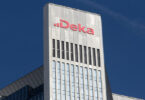Three months ago, T-Systems, a division of Deutsche Telekom, announced its blockchain Validation as a Service. The initial product is to provide staking services for the yet-to-launch public blockchain Polkadot alongside other blockchains. Although T-Systems delivers end-to-end services for enterprise blockchain, as an infrastructure provider, it envisions public blockchain services as a core offering. And it already sees a proven business case.
For now, enterprises using public blockchains are newsworthy. But this is gradually starting to change with the combination of Facebook’s Libra, the need for interoperability, and the availability of privacy solutions for public blockchains.
One could argue that parent Deutsche Telekom is already participating in a public distributed ledger (DLT) as a member of the governing council of Hedera Hashgraph. However, it’s both positioned as an enterprise DLT and the nature of Hedera’s governance means it’s permissioned.
Stepping back, the first early public blockchains such as Bitcoin and Ethereum have relied on energy-intensive Proof of Work calculations to prevent spam being added to the networks. The Ethereum community is working on a Proof of Stake version Ethereum 2.0, which instead gets people to put their tokens on the line or stake them, to prevent bad behavior when validating transactions. Other examples of PoS blockchains include Polkadot, Cosmos and Tezos.
Proof of Stake blockchains mint new tokens for every block as a reward for providing network infrastructure and compensation to token holders for risking their tokens when validating blocks of transactions. As a result, there’s natural inflation of the cryptocurrencies.
With conventional banking in inflationary times, it makes more sense to earn interest from a bank, rather than keeping money under your mattress, because inflation means the currency declines in real value.
Likewise, because PoS blockchains are inflationary, token owners are motivated to let others use their tokens for staking to earn rewards similar to interest. For most token holders, rather than running validator nodes themselves, they will get staking services to do this on their behalf.
Because token holders stake their tokens, if there’s bad behavior, some or all of their tokens can be lost. But it’s not just fraudsters that risk losing tokens. If a validation service becomes unavailable on some PoS networks such as Polkadot, that can also be penalized. These penalties are referred to as slashing.
The Polkadot attraction
Before exploring the service itself, a question is why did T-Systems choose Polkadot for its validation service.
For now, T-Systems offerings are partly driven by demand. The organization is interested in other blockchains as well, including Ethereum 2.0, which is still some way off launching. Plus it is getting involved with other PoS protocols launching soon.
Gleb Dudka, an analyst at T-Systems Multimedia Solutions (MMS), outlined interoperability between various application-specific blockchains, and especially consortia blockchains as a key driver.
There are two public blockchains with an interoperability focus. One is the Cosmos Network, where the native emphasis is on asset interoperability, although it is morphing to broader interoperability as well. The network itself is already live with the interoperability module (so-called IBC) in the final stage of development.
The other network is Polkadot, which natively supports the interoperability of both assets and smart contracts, which is the main enabler, especially for enterprise applications. The ability to exchange assets between different networks is a challenge in itself, but far easier than enabling smart contract interoperability.
“The DOTs, the native token of the Polkadot network, allows someone to connect their own blockchain to the Polkadot universe, making it interoperable with other Polkadot blockchains,” said Dudka.
Polkadot can enable two private blockchains or “parachains” to interact, and potentially a private blockchain can be interoperable with a public blockchain. Hence, it addresses both privacy as well as scalability. Because with interoperability, individual blockchains can become more optimized for narrow use cases making them more scalable.
Dudka continued: “But we do see (demand from) German enterprise clients, one of whom we are in discussion with about this service. They also see the benefits of Polkadot in the long term. So they’d like to take an active part in the network, including on-chain governance because tokens also give governance rights. Hence they want to be one of the validators to steer how the protocol is moving as well.”
An industry that particularly needs interoperability is insurance. For example, insurers need to be able to access trade data to provide insurance for invoices financed by banks or for warehoused goods.
However, asked whether the appetite for staking services was for enterprise applications, Dudka acknowledged that in the B2B world, 90% of demand currently is coming from institutional investors and funds. But as the utility of the network increases, he expects there will be a shift towards applications.
The B2B service to be offered by T-Systems is to run validator nodes on behalf of enterprise clients as part of its German Blockchain Ecosystem offering.
Meanwhile, Polkadot also has a German pedigree with the headquarters of Parity, the company that initiated the Polkadot project, in Berlin.
So if interoperability is a driver behind selecting Polkadot, the next question is, how can T-Systems add value to Validation as a Service?
T-Systems’ competitive advantage for staking services
The vast majority of staking services are run by startups using the big cloud providers Amazon AWS, Microsoft’s Azure and Google Cloud as well as hosting service Digital Ocean. If one of them has an outage, that could be costly to a large number of token holders who could experience slashing penalties. A significant benefit of T-Systems as a relatively niche German player is its cloud infrastructure doesn’t correlate with these services.
Additionally, the vast majority of T-Systems’ clients are enterprise clients who are gradually taking an interest in public blockchains. Most companies that offer staking as a service are startups that might struggle to pass enterprise compliance requirements.
Looking at the big picture, other potential providers of staking services might include custodians. “We’re talking with emerging regulated German custodians, with a pending BAFIN (German regulator) license,” said Dudka. We previously reported that apart from technology custodians, more than 40 banks have expressed an interest in German digital asset custodian licenses.
Dudka continued: “The clear statement from most of them and Anchorage which you brought up, is they don’t plan to do this themselves as far as I know but do it in partnership with a staking as a service provider. I think the only one that does it is Coinbase Custody. But they also might be looking forward to working with third-party staking providers for certain protocols.”
That’s very likely the case for now. But for specialist custody providers, particularly companies like Anchorage, which are positioned as technology solution providers, we’d predict that in the future, they may provide these staking services themselves. That’s a view that Dudka disagrees with given that some blockchains have highly specialized requirements for staking.
Not mentioned during the Ledger Insights interview, Dudka is an expert in staking. Apart from his day job at T-Systems MMS, he is an editor of Staking Rewards, a popular website that provides data on the sector.
The next question is whether providing a staking service is a money maker.
The revenues earned by staking providers can be gleaned from public data because of the transparency of public blockchains, and the figures are attractive. T-Systems will be providing enterprise-grade services, and B2B and institutional clients are not particularly price sensitive. They value security over staking returns, which in turn might mean accepting a higher fee.
Currently, the Staking-aaS or Validation-aaS market is going through a race to the bottom when it comes to fees, ranging from zero to ten percent of the staking rewards. However, some institutional-focused custodians can charge up to 25% validator fees, for example, the Coinbase Custody fee relating to Tezos.
The staking rewards themselves vary substantially. For Tezos, the rate is 5.69% and Cosmos 8.2% before adjusting for inflation.
T-Systems’ existing infrastructure strengths, combined with demand from German enterprise and institutional clients, interest from custodians and a good business model, make this appealing.
But the head of T-Systems MMS’ Blockchain Solutions Center, Dr. Andreas Dittrich, acknowledged there was still some persuading to do. “The business case itself is valid already, and the demand is there,” said Dittrich.
What about enterprise blockchain?
Dittrich outlined a handful of high-profile enterprise blockchain use cases that the Blockchain Solutions Center has worked on. One example is a project for one of the major German car manufacturers using zero knowledge proofs to verify driver license credentials.
Another involves the Federal Agency for migration and refugees (BAMF). The application doesn’t store any migrant personal information but transparently tracks the processing between different government departments.
A German town has already launched a local currency to be used for payments for public services and to give rewards. The solution could potentially be used for other towns.
While T-Systems will continue to work on use cases, in the future, it envisions making templates from these sorts of applications that could be deployed on public blockchains.
“Implementing use cases is not what we think we will be doing in two to three years,” said Dittrich. “We see ourselves as a telecommunication provider. We see ourselves as providing the base services to support whatever use case is going to fly in the future, blockchain being one of the technologies we believe will be a base technology in the future.”
He concluded: “The switch from use case business to use case agnostic and public network infrastructure services like the validation service, we think that’s the logical progression, home turf. And you might even say the duty of a telecoms provider such as Deutsche Telekom.”
The author does not own any cryptocurrencies







